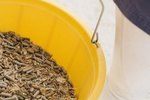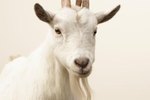
Gypsy horses, also known as Tinker or Vanner horses, are beloved for their dramatic movement and looks, as well as their gentle and willing dispositions. A stout, colorful breed, Gypsy horses are revered for their versatility and athleticism. Choosing the right feed for a Gypsy horse may depend on the mount's age, workload and body condition, and can contribute to his overall health and performance.
Workload and Age
A horse's workload can determine the amount of feed he receives. Performance horses who are challenged anaerobically need higher amounts of carbohydrates, according to the Texas A&M Extension website. Horses with particularly high performance expectations can eat a high carbohydrate diet supplemented with a feed-grade vegetable oil. Performance horses may require slightly more protein in their diets than pleasure mounts, and young or lactating horses will require more than mature horses.
Easy Keepers
Gypsy horses are described by the Gypsy Vanner Horse Society as being "easy keepers," which means they require less feed than other horse breeds to maintain a healthy body condition. Obesity can lead to performance difficulties, excess sweating and occasionally, laminitis. Keeping an easy keeper healthy might mean switching his hay from legume or clover alfalfa hay to a high fiber grass hay, and engaging him in a regular exercise program. Easy keepers such as the Gypsy Vanner may require limited grazing time, particularly in the spring when grass grows rapidly.
Body Condition
Body condition scoring aids owners and caretakers in assessing a horse's overall health. Scores take in views of the horse from the front, the rear and both sides. A body condition score of 5 is considered moderate and is in the ideal range, according to the Southern States feed supply website. Neither fat nor thin, horses with this body condition score appear healthy, and the ribs can be felt when palpated with the hand. Most horse feeds are made to be fed at a rate of 0.5 percent of the horse's body weight.
Feed Types
When it comes to selecting a feed, the choices are many. A concentrate can be chosen based upon a horse's age, his access to forage and his performance level. Feed is usually labeled to indicate the type of horse it is intended for. Textured concentrates, also called sweet feeds, are mixed with molasses to improve taste. Some animal caretakers shun sweet feed, believing that the sugar content interferes with horse manageability. Pelleted feeds are easily digested and ensure nutrient absorption, though they are more expensive due to more complicated processing. Complete feeds include roughage for horses with little access to hay or grass.
References
- Gypsy Vanner Horse Society: Why Get a Gypsy Vanner
- Southern States: Feeding the Draft Horse
- Southern States: Feeding the Easy Keeper
- Texas A&M Agrilife Extension: Feeding the Performance Horse
- Southern States: Body Scoring Guide
- University of Nebraska-Lincoln Extension: Basics of Feeding Horses: Reading the Tag
Photo Credits
-
BananaStock/BananaStock/Getty Images



